Marc Huertas-Company
UniverseTBD
AstroLLaVA: towards the unification of astronomical data and natural language
Apr 11, 2025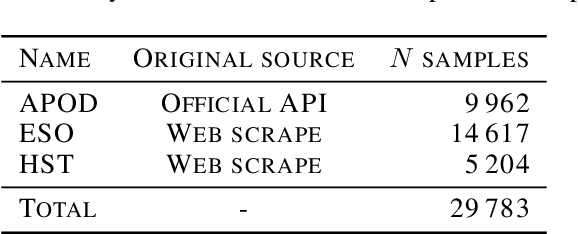
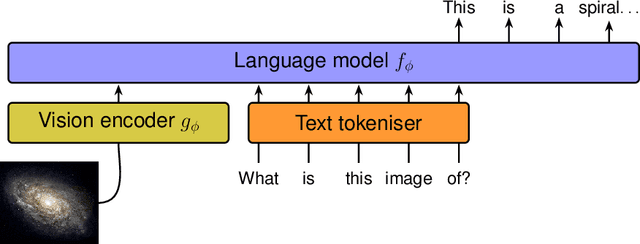
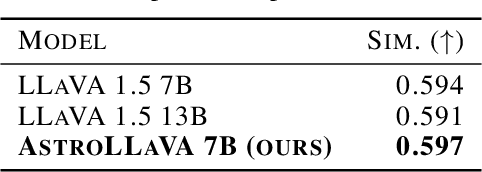

Abstract:We present AstroLLaVA, a vision language model for astronomy that enables interaction with astronomical imagery through natural dialogue. By fine-tuning the LLaVA model on a diverse dataset of $\sim$30k images with captions and question-answer pairs sourced from NASA's `Astronomy Picture of the Day', the European Southern Observatory, and the NASA/ESA Hubble Space Telescope, we create a model capable of answering open-ended questions about astronomical concepts depicted visually. Our two-stage fine-tuning process adapts the model to both image captioning and visual question answering in the astronomy domain. We demonstrate AstroLLaVA's performance on an astronomical visual question answering benchmark and release the model weights, code, and training set to encourage further open source work in this space. Finally, we suggest a roadmap towards general astronomical data alignment with pre-trained language models, and provide an open space for collaboration towards this end for interested researchers.
A Survey on Hypothesis Generation for Scientific Discovery in the Era of Large Language Models
Apr 07, 2025Abstract:Hypothesis generation is a fundamental step in scientific discovery, yet it is increasingly challenged by information overload and disciplinary fragmentation. Recent advances in Large Language Models (LLMs) have sparked growing interest in their potential to enhance and automate this process. This paper presents a comprehensive survey of hypothesis generation with LLMs by (i) reviewing existing methods, from simple prompting techniques to more complex frameworks, and proposing a taxonomy that categorizes these approaches; (ii) analyzing techniques for improving hypothesis quality, such as novelty boosting and structured reasoning; (iii) providing an overview of evaluation strategies; and (iv) discussing key challenges and future directions, including multimodal integration and human-AI collaboration. Our survey aims to serve as a reference for researchers exploring LLMs for hypothesis generation.
Bayesian Deconvolution of Astronomical Images with Diffusion Models: Quantifying Prior-Driven Features in Reconstructions
Nov 28, 2024Abstract:Deconvolution of astronomical images is a key aspect of recovering the intrinsic properties of celestial objects, especially when considering ground-based observations. This paper explores the use of diffusion models (DMs) and the Diffusion Posterior Sampling (DPS) algorithm to solve this inverse problem task. We apply score-based DMs trained on high-resolution cosmological simulations, through a Bayesian setting to compute a posterior distribution given the observations available. By considering the redshift and the pixel scale as parameters of our inverse problem, the tool can be easily adapted to any dataset. We test our model on Hyper Supreme Camera (HSC) data and show that we reach resolutions comparable to those obtained by Hubble Space Telescope (HST) images. Most importantly, we quantify the uncertainty of reconstructions and propose a metric to identify prior-driven features in the reconstructed images, which is key in view of applying these methods for scientific purposes.
pathfinder: A Semantic Framework for Literature Review and Knowledge Discovery in Astronomy
Aug 02, 2024



Abstract:The exponential growth of astronomical literature poses significant challenges for researchers navigating and synthesizing general insights or even domain-specific knowledge. We present Pathfinder, a machine learning framework designed to enable literature review and knowledge discovery in astronomy, focusing on semantic searching with natural language instead of syntactic searches with keywords. Utilizing state-of-the-art large language models (LLMs) and a corpus of 350,000 peer-reviewed papers from the Astrophysics Data System (ADS), Pathfinder offers an innovative approach to scientific inquiry and literature exploration. Our framework couples advanced retrieval techniques with LLM-based synthesis to search astronomical literature by semantic context as a complement to currently existing methods that use keywords or citation graphs. It addresses complexities of jargon, named entities, and temporal aspects through time-based and citation-based weighting schemes. We demonstrate the tool's versatility through case studies, showcasing its application in various research scenarios. The system's performance is evaluated using custom benchmarks, including single-paper and multi-paper tasks. Beyond literature review, Pathfinder offers unique capabilities for reformatting answers in ways that are accessible to various audiences (e.g. in a different language or as simplified text), visualizing research landscapes, and tracking the impact of observatories and methodologies. This tool represents a significant advancement in applying AI to astronomical research, aiding researchers at all career stages in navigating modern astronomy literature.
AstroPT: Scaling Large Observation Models for Astronomy
May 23, 2024Abstract:This work presents AstroPT, an autoregressive pretrained transformer developed with astronomical use-cases in mind. The AstroPT models presented here have been pretrained on 8.6 million $512 \times 512$ pixel $grz$-band galaxy postage stamp observations from the DESI Legacy Survey DR8. We train a selection of foundation models of increasing size from 1 million to 2.1 billion parameters, and find that AstroPT follows a similar saturating log-log scaling law to textual models. We also find that the models' performances on downstream tasks as measured by linear probing improves with model size up to the model parameter saturation point. We believe that collaborative community development paves the best route towards realising an open source `Large Observation Model' -- a model trained on data taken from the observational sciences at the scale seen in natural language processing. To this end, we release the source code, weights, and dataset for AstroPT under the MIT license, and invite potential collaborators to join us in collectively building and researching these models.
A brief review of contrastive learning applied to astrophysics
Jun 08, 2023Abstract:Reliable tools to extract patterns from high-dimensionality spaces are becoming more necessary as astronomical datasets increase both in volume and complexity. Contrastive Learning is a self-supervised machine learning algorithm that extracts informative measurements from multi-dimensional datasets, which has become increasingly popular in the computer vision and Machine Learning communities in recent years. To do so, it maximizes the agreement between the information extracted from augmented versions of the same input data, making the final representation invariant to the applied transformations. Contrastive Learning is particularly useful in astronomy for removing known instrumental effects and for performing supervised classifications and regressions with a limited amount of available labels, showing a promising avenue towards \emph{Foundation Models}. This short review paper briefly summarizes the main concepts behind contrastive learning and reviews the first promising applications to astronomy. We include some practical recommendations on which applications are particularly attractive for contrastive learning.
A Deep Learning Approach for Characterizing Major Galaxy Mergers
Feb 09, 2021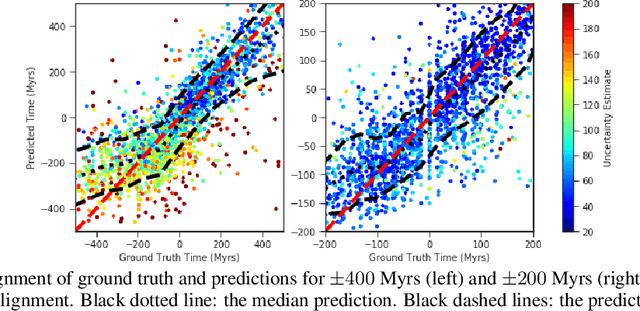

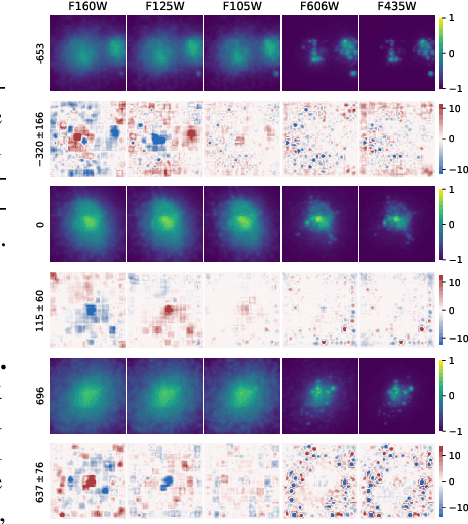
Abstract:Fine-grained estimation of galaxy merger stages from observations is a key problem useful for validation of our current theoretical understanding of galaxy formation. To this end, we demonstrate a CNN-based regression model that is able to predict, for the first time, using a single image, the merger stage relative to the first perigee passage with a median error of 38.3 million years (Myrs) over a period of 400 Myrs. This model uses no specific dynamical modeling and learns only from simulated merger events. We show that our model provides reasonable estimates on real observations, approximately matching prior estimates provided by detailed dynamical modeling. We provide a preliminary interpretability analysis of our models, and demonstrate first steps toward calibrated uncertainty estimation.
 Add to Chrome
Add to Chrome Add to Firefox
Add to Firefox Add to Edge
Add to Edge